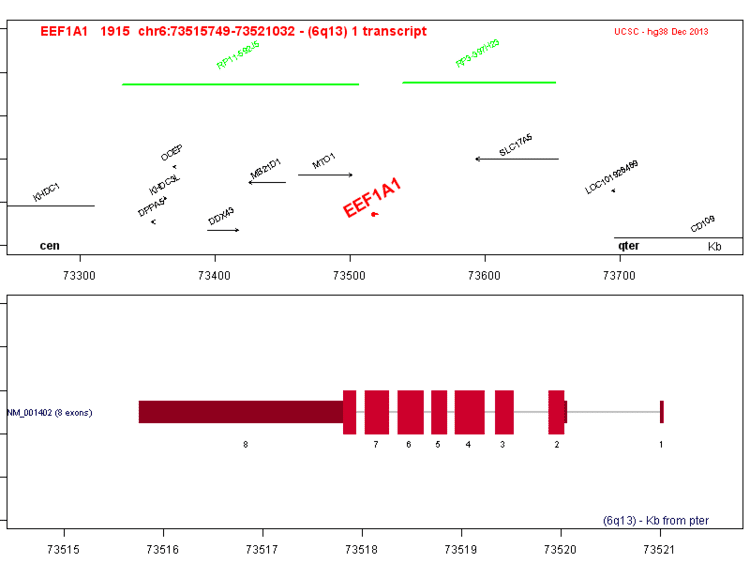Entrez 1915 | Ensembl ENSG00000156508 | |
 | ||
Aliases EEF1A1, CCS-3, CCS3, EE1A1, EEF-1, EEF1A, EF-Tu, EF1A, GRAF-1EF, HNGC:16303, LENG7, PTI1, eEF1A-1, eukaryotic translation elongation factor 1 alpha 1 External IDs MGI: 1096881 HomoloGene: 100799 GeneCards: EEF1A1 | ||
Gene music using protein sequence of eef1a1 eukaryotic translation elongation factor 1 alpha 1
Elongation factor 1-alpha 1 (eEF1a1) is a protein that in humans is encoded by the EEF1A1 gene.
Contents
- Gene music using protein sequence of eef1a1 eukaryotic translation elongation factor 1 alpha 1
- Structure
- Function
- Clinical Significance
- Interactions
- References
This gene encodes an isoform of the alpha subunit of the elongation factor-1 complex, which is responsible for the enzymatic delivery of aminoacyl tRNAs to the ribosome. This isoform (alpha 1) is expressed in brain, placenta, lung, liver, kidney, and pancreas, and the other isoform (alpha 2) is expressed in brain, heart and skeletal muscle. This isoform is identified as an autoantigen in 66% of patients with Felty's syndrome. This gene has been found to have multiple copies on many chromosomes, some of which, if not all, represent different pseudogenes.
Structure
Mammalian eEF1A possesses two isoforms, eEF1A1 and eEF1A2, with high amino acid sequence homology (approximately 90% identity). The sequences of their promoter regions are also highly similar, though that of the eEF1A2 gene contains an additional 81 bp SV40 small antigen sequence at the 5′-end. The EEF1A1 5' UTR also contains a terminal oligopyrimidine tract. Thus, these two isoforms demonstrate differences in expression and function: eEF1A1 is expressed in most cells while eEF1A2 is only expressed in adult neuronal and muscle cells, and only eEF1A1 induces HSP70 during heat shock.
Function
The eEF1A1 protein is an isoform of the eEF-1 complex alpha subunit, an elongation factor protein, a GTPase, and an actin bundling protein. As an elongation factor, it is known to mediate the recruitment of aminoacyl-tRNA to the A-site of the 80S ribosome during protein synthesis. As a result, this protein is ubiquitously expressed.
In addition to its role in translation, eEF1A has been shown to play a central role in the nuclear export of proteins. Thus, eEF1A can be found in both the cytoplasm for translation and in the nucleus for nuclear transport. VHL, PABP1 and other proteins containing a TD-NEM (Transcription Dependent Nuclear Export Motif) are exported by eEF1A in a manner that is dependent on ongoing RNA polymerase II (RNA PolII)-dependent transcription.
Moreover, it participates in several processes required for cell growth and proliferation, including cytoskeleton organization, mitotic apparatus formation, and signal transduction. This protein colocalizes with filamentous actin (F-actin) and is just as abundantly expressed. eEF1A putatively binds actin and microtubules at synapses to modulate the cytoskeleton. In neurons, this ability allows for regulation of the number and size of inhibitory postsynaptic complexes like postsynaptic gephyrin clusters. eEF1A has also been found to bind to several kinases, phospholipases, and synaptic proteins. For instance, while associated with actin, it can activate phosphatidylinositol 4-kinase, which then regulates phosphatidylinositol 4-phosphate and phosphatidylinositol 4,5-bisphosphate levels. This protein can also act as a membrane receptor for the cryptic antiadhesive site of fibronectin, thus inhibiting cell anchorage and promoting apoptosis, or anoikis. Though it has not been observed to localize to the cell membrane, it can be found in the outer cell surface. Its role in apoptosis may also contribute to regulation of cell growth and the immune response.
Additional functions of eEF1A1 include: serving as a coactivator of the mineralocorticoid receptors in the heart and kidney to enhance expression of endogenous GILZ, SGK1, and CNKSR3; mediating the TNFα-induced decrease in endothelial nitric oxide synthase mRNA stability; detecting misfolded proteins and targeting them to the proteosome for proteolytic degradation; stabilizing viral and cellular RNAs by binding the 3' region; regulating transcription by recruiting and activating HSF1; and induction of HSP70 during heat shock.
Clinical Significance
Upregulation of eEF1A has been reported in breast cancer samples. Though its role in metastasis remains unclear, the role of eEF1A in cytoskeleton organization may promote tumor cell motility and thus spread. Alternatively, apoptotic cells may secrete antigens, including eEF1A and other elongation factors, to induce an autoimmune response during cancer. It is postulated that high expression and secretion of elongation factors from tumor tissues, combined with altered levels of eEF1A-derived bacterial peptides in neoplastic disease, may lead to autoimmunity in breast cancer.
As with breast cancer, upregulation of eEF1A expression is associated with prostate cancer and worsened metastasis-free and overall patient survival. Moreover, a truncated form of the eEF1A1 protein, prostate tumour inducing gene 1 (PTI-1), has been detected in prostate carcinoma patient-derived blood samples. As eEF1A1 is over-expressed in osteoblasts, which proliferate and differentiate in the presence of tumor cells, it may serve as a serum biomarker to track the metastatic progression of prostate cancer.
In the case of acute T lymphocytic leukemia, knocking down the eEF1A1 gene produces inhibited proliferation and induced apoptosis of Jurkat cells. These effects may be attributed to the resulting down-regulation of the PI3K/Akt/NF-κB and PI3K/Akt/mTOR signaling pathways.
eEF1A1 is downregulated in myocardial infarction and potentially participates in cardiovascular disease through its interactions with mineralocorticoid receptors in the heart. Its role in heat shock response presents it as a target for treating related diseases like spinal and bulbar muscular atrophy (SBMA) and amyotrophic lateral sclerosis (ALS).
Interactions
Eukaryotic translation elongation factor 1 alpha 1 has been shown to interact with:
